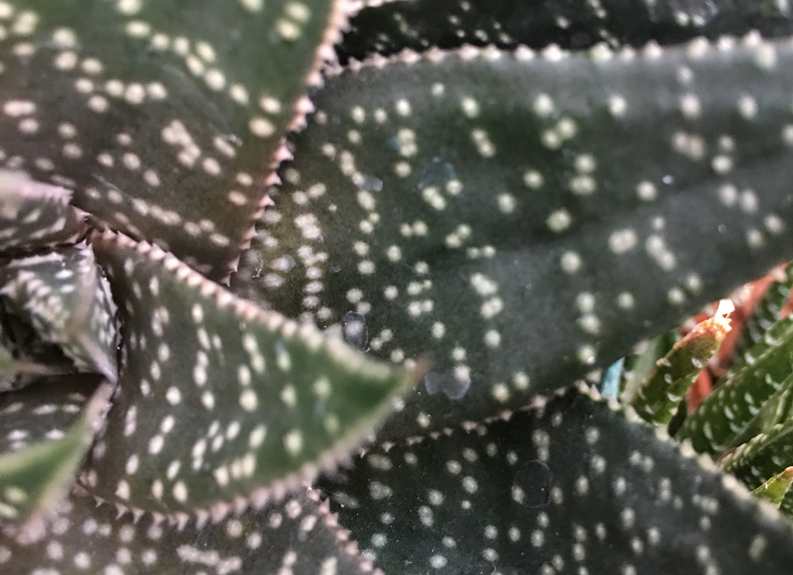
Among the plants in my greenhouse are many in the Gasteria family, a type sometimes called “Cow’s Tongue” due to their thick stems, lack of leaves and dappled surface coloration. Many Gasterias display varying patterns of white spots on green backgrounds, which vary from species to species and are often quite dramatic. This feature makes Gasterias popular in many collections.
While comparing the coloration between plants the other day, I also compared the pattern of spots on different stems of one plant. While a particular pattern adorns each stem, no two stems display exactly the same pattern; the specific location, size and spatial relationship of spots appear randomly arranged within the confines of that plant’s overall pattern or schema. Understanding that genetics, as in all living things, provides the basic framework or blueprint guiding the shape, form, color and other characteristics of each plant, it nonetheless occurred to me that each stem’s pattern of spots manifests a certain “freedom of expression.” This left me wondering; what mechanism dictates the creation and positioning of such spots?
Gratefully, the Internet provided me with information necessary to answer my question; what I took to be freedom of expression is in fact the outcome of dynamic cellular interdependence. The dot patterns on each stem are indeed random, but a complex set of cellular, chemical and physical conditions dictate how that randomness is expressed.
Expression is a term used in genetics to mean that a particular gene is “turned on” or “turned off.” Some gene expression is controlled by other genes or triggered by external conditions such as environment, sunlight, temperature, moisture, etc. In the case of the white spots on Gasteria stems, adjacent cells interacting with each other influence the expression of coloration genes, either stimulating or repressing spot creation in an intricate dance of chemical messaging. In essence, though the plant’s overall patterning is genetically determined, the final arrangement of dots is not predetermined and is instead the outcome of a dynamic relationship between individual cells.
Taken as a metaphor for life in general, one observes how this dynamic of stimulation and repression plays out moment to moment. Though we live within the general confines of our genetic code, dynamic interdependence offers us a high degree of freedom of expression, which we experience as matters of choice, chance and interaction. Unless one believes that each and every event in the universe is decided by an omniscient and all powerful deity, life’s dynamic is in essence “making itself up” as it happens, randomly creating unique variations of each moment “on the spot,” or in the case of Gasteria, “in the spot.”
Our fascination with games of chance reflects awareness of inherently self-creative interdependence and freedom of expression. Though simple cause and effect can sometimes be observed and conclusions drawn, each moment actually represents unfathomable conditions of complexity well beyond our limited powers of observation, prediction or control.
That said, humans are particularly adept at pattern recognition, and our obsession with data, statistics, computers and all things digital is one result. Computing power notwithstanding, life in this universe is now 13.7 billion years in the making; accordingly, it will always contain the character and appearance of chaos. Just as the spot patterns on stems of Gasteria self-express, each of us are randomly unique expressions inseparably bound to the vagaries of chance and the freedom and interdependence of life’s dynamic.